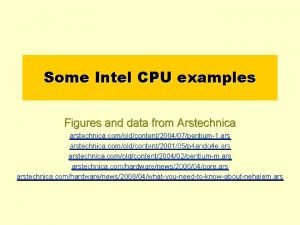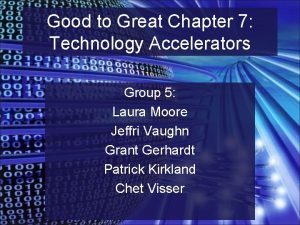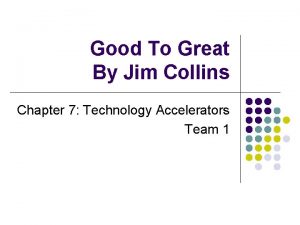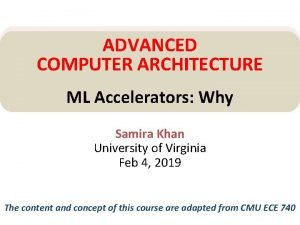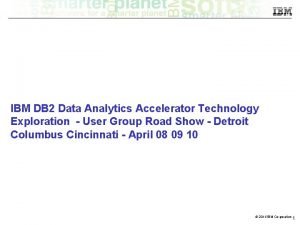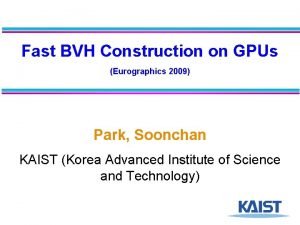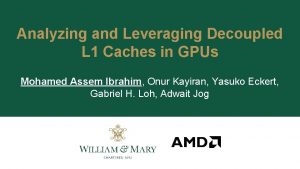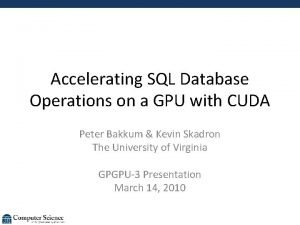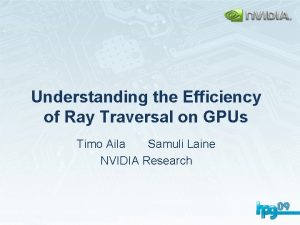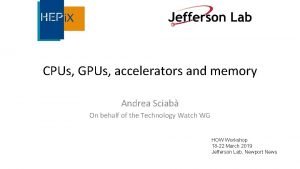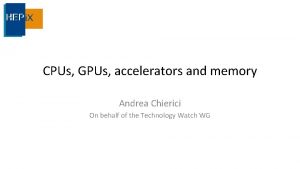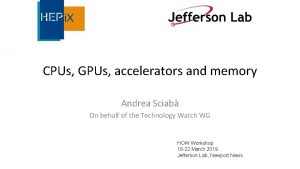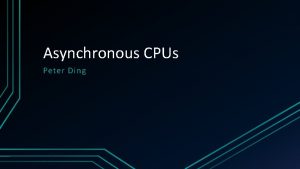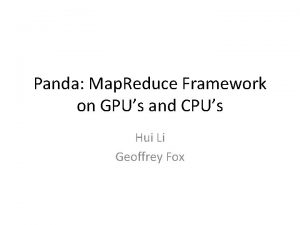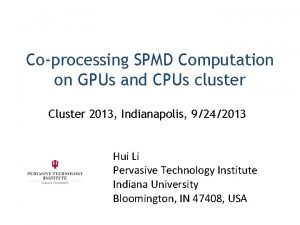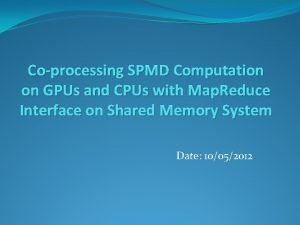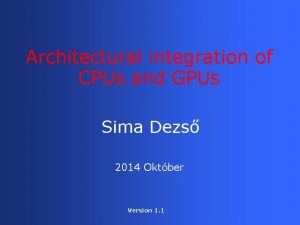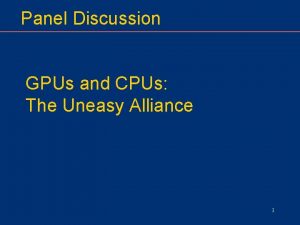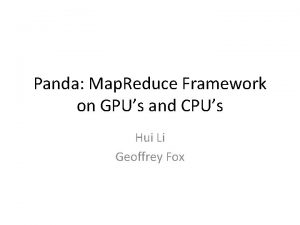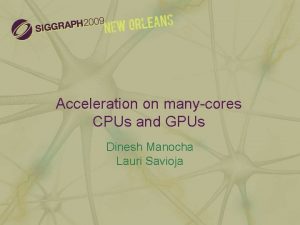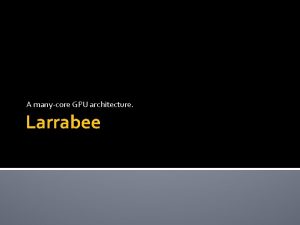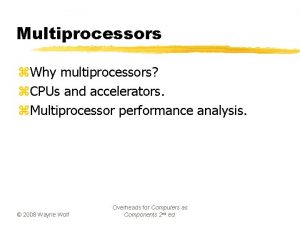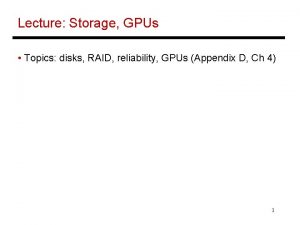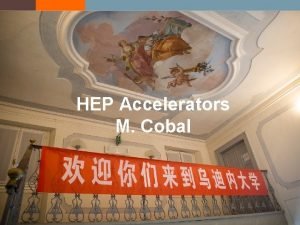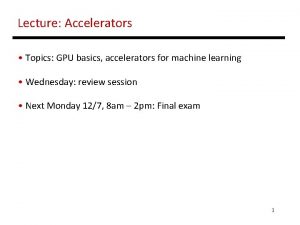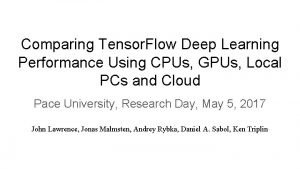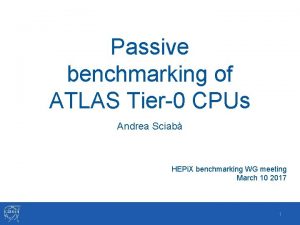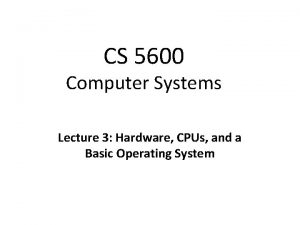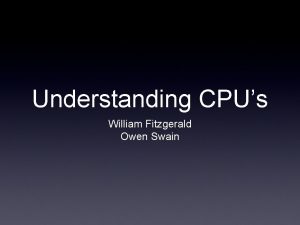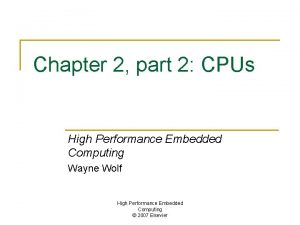T F A R D CPUs GPUs accelerators


































- Slides: 34

T F A R D CPUs, GPUs, accelerators and memory Andrea Sciabà On behalf of the Technology Watch WG HOW Workshop 18 -22 March 2019 Jefferson Lab, Newport News

Introduction • The goal of the presentation is to give a broad overview of the status and prospects of compute technologies – Intentionally, with a HEP computing bias • Focus on processors and accelerators – Not anymore just R&D, but soon to be used in production by LHC experiments • The wider purpose of the working group is to provide information that can be used to optimize investments – Market trends, price evolution • More detailed information is already available in a document – Soon to be added to the WG website 2

Outline • General market trends • CPUs – Intel, AMD – ARM – Specialized CPUs – Other architectures • • GPUs FPGAs Interconnect, packaging and manufacturing technologies Memory technologies 3

Semiconductor device market and trends • Global demand for semiconductors topped 1 trillion units shipped for the first time • Global semiconductor sales got off to a slow start in 2019, as year-to-year sales decreased • Long-term outlook remains promising, due to the ever-increasing semiconductor content in a range of consumer products • Strongest unit growth rates foreseen for components of – smartphones – automotive electronics systems – devices for deep learning applications 4

Semiconductor fabrication • Taiwan leading all regions/countries in wafer capacity • TSMC held 67% of Taiwan’s capacity and is leading • Samsung and SK Hynix represent 94% of the installed IC wafer capacity in South Korea – They are likely to influence memory prices (which are now very high) • New manufacturing lines are expected to boost industry capacity by 8% in both 2018 and 2019 5

Process technology • Performance scaling in process technology continues to grow Moore’s law prediction • Embedded processors benefit the most from process manufacturing improvements • EUV is forecast to be the dominant lithography technology in the coming years 6

Market share of technology companies Server companies PC companies • Worldwide server market increased 38%, year over year to $23 billion during the third quarter of 2018 7

Intel and AMD market share • AMD server market share is rapidly increasing since 2017, but from almost nothing Source: Passmark website – Zen architecture released in 2017 – Might reach 2% by the end of 2019 • Negligible impact on Intel market share so far • AMD always had a reasonable (20 -30%) share overall • EPYC revenue was $58 m in the second 2018 quarter vs $36 m in the prior quarter 8

Internet and smart population growth and effects • Small changes in smart population trend from 2018 • Significant increase in mobile social media usage over the past year 9

CPUS: X 86 AND ARM 10

Intel server CPU line-up • Intel Xeon Scalable Processors – Currently based on Skylake-SP and coming in four flavours, up to 28 cores • Only minor improvements foreseen for 2019 – Adding support for Optane DC Persistent Memory and hardware security patches • New microarchitecture (Sunny Cove) to become available late 2019 – Several improvements benefiting both generic and specialised applications 11

Current and future Intel server architectures Microarchitecture Technology Launch year Highlights Skylake-SP 14 nm 2017 Improved frontend and execution units More load/store bandwidth Improved hyperthreading AVX-512 Cascade Lake 14 nm++ 2019 Vector Neural Network Instructions (VNNI) to improve inference performance Support 3 D XPoint-based memory modules and Optane DC Security mitigations Cooper Lake 14 nm++ 2020 bfloat 16 (brain floating point format) Sunny Cove 10 nm+ 2019 Single threaded performance New instructions Improved scalability Larger L 1, L 2, μop caches and 2 nd level TLB More execution ports AVX-512 Willow Cove 10 nm 2020? Cache redesign New transistor optimization Security Features Golden Cove 7/10 nm? 2021? Single threaded performance AI Performance Networking/5 G Performance Security Features 12

Other Intel x 86 architectures • Xeon Phi – Features 4 -way hyperthreading and AVX-512 support – Elicited a lot of interest in the HEP community and for deep learning applications – Announced to be discontinued in summer 2018 • Networking processors (Xeon D) – So. C design – Used to accelerate networking functionality or to process encrypted data streams – Two families, D-500 for networking and D-100 for higher performance, based on Skylake -SP with on-package chipset – Hewitt Lake just announced, probably based on Cascade Lake • Hybrid CPUs – Will be enabled by Foveros, the 3 D chip stacking technology recently demonstrated 13

AMD server CPU line-up • EPYC 7000 line-up from 2017 – Resurgence after many years of Bulldozer CPUs thanks to the Zen microarchitecture • +40% in IPC, almost on par with Intel • 2 x power efficiency vs Piledriver – Up to 32 cores • Already being tested and used at some WLCG sites 14

EPYC Naples • EPYC Naples (Zen) consists of up to 4 separate dies, interconnected via Infinity Fabric – Chiplets allow a significant reduction in cost and higher yield • Main specifications – up to 32 cores – 4 dies per chip (14 nm), each die embedding IO and memory controllers – 2. 0 -3. 1 GHz of base frequency – 8 DDR 4 memory channels with hardware encryption – up to 128 PCI gen 3 lanes per processor (64 in dual ) – TDP range: 120 W-200 W • Similar per-core and per-GHz HS 06 performance to Xeon 15

EPYC Rome • Next AMD EPYC generation (Zen 2), embeds 9 dies, including one for I/O and memory access – Aimed at competing with Ice Lake (!) • Main specs: – 9 dies per chip : a 14 nm single IO/memory die and 8 CPU 7 nm chiplets • +300 -400 MHz for low core count CPUs 8 DDR 4 memory channels, up to 3200 MHz up to 64 cores up to 128 PCI Gen 3/4 lanes per processor TDP range: 120 W-225 W (max 190 W for SP 3 compatibility) Claimed +20% performance per-core over Zen, +75% through the whole chip with similar TDP over Naples – To be released during 2019 – – – 16

ARM in the data center • ARM is ubiquitous in the mobile and embedded CPU word • Data center implementations have been relatively unsuccessful so far – Performance/power and performance/$ not competitive with Intel and AMD • LHC experiments are capable of using ARM CPUs if needed – Some do nightly builds on Arm since years • Only a few implementations relevant to the data center – – – Arm Neoverse Cavium Thunder. X 2 Ampere e. MAG Fujitsu A 64 FX Huawei Kunspeng 920 17

Marvell Thunder. X 2 and Fujitsu A 64 FX • Thunder. X 2 for mainstream cloud and HPC data centers, from 2018 – Enjoys the greatest market visibility and reasonable performance/$ • Used e. g. at CRAY XC-50 at Los Alamos and HPE Apollo 70 based Astra HPC system at Sandia National Laboratory – ARM V 8. 1 architecture • Up to 32 cores, 4 -way SMT • Up to 8 DDR 4 memory channels • Up to 56 PCIe Gen 3 lanes • Fujitsu A 64 FX to be used in supercomputer at RIKEN center – Based on the V 8. 2 -A ISA architecture • • First to deliver scalable vector extentions (SVE) 48 cores 32 GB of HBM 2 high bandwidth memory 7 nm Fin. FET process – Interesting to see what performance will achieve as it may lead to a more competitive product 18

ARM Neoverse • Two platforms for the data center – N 1 for cloud, E 1 for throughput • Based on the Neoverse N 1 CPU – Very similar architecture to Cortex A 76 but optimized for high clock speeds (up to 3. 1 GHz) – Two N 1 cores each with L 1 and L 2 caches – To be combined by licensees with memory controller, interconnect and I/O IP • Demonstrated the N 1 Hyperscale Reference Design – – 64 -128 N 1 CPUs each with 1 MB of private L 2 8 x 8 mesh interconnect with 64 -128 MB of shared cache 128 x PCIe/CCIX lanes 8 x DDR 4 memory channels • Intended to strengthen ARM’s server market share – Not expected to be available for another 1 -1. 5 years Source: Anandtech 19

IBM POWER • POWER 9 – Used in Summit, the fastest supercomputer – 4 GHz – Available with 8 -way SMT (up to 12 cores) and 4 way (up to 24 cores) – CAPI 2. 0 I/O to enable • Coherent user-level access to accelerators and I/O devices • Access to advanced memories – NVLink to increase bandwidth to Nvidia GPUs – 14 nm FINFET process • POWER 10 – 10 nm process – Several feature enhancements – First to support PCIe Gen 5 20

Discrete GPUs: current status • GPU’s raw power follows the exponential trend on numbers of transistors and cores • New features appear unexpectedly, driven by market (e. g. tensor cores) – Tensor cores: programmable matrix-multiply-and-accumulate units – Fast half precision multiplication and reduction in full precision – Useful for accelerating deep learning training/inference https: //devblogs. nvidia. com/programming-tensor-cores-cuda-9/ 21

Nvidia and AMD • Volta addressing the server market, Turing the gaming market Feature Volta Turing Process 12 nm CUDA cores yes Tensor cores yes RT cores NA yes FP performance FP 16: 30 TFLOPS FP 32: 15 TFLOPS FP 64: 7. 5 TFLOPS Tensor: 120 TFLOPS ? Multi-GPU NVLink 2/SLI Applications AI, datacenter, workstation AI, workstation, gaming • Vega 20 – Directly aimed at the server world (Instinct MI 50 and MI 60) • Evolution of Vega 10 using a 7 nm process – – more space for HBM 2 memory, up to 32 GB 2 x memory bandwidth Massive FP 64 gains PCIe Gen 4 • Some improvements relevant for inference scenarios – Support for INT 8 and INT 4 data types – Some new instructions 22

GPUs - Programmability • NVIDIA CUDA: – C++ based (supports C++14), de-facto standard – New hardware features available with no delay in the API • Open. CL: – Can execute on CPUs, AMD GPUs and recently Intel FPGAs – Overpromised in the past, with scarce popularity • Compiler directives: Open. MP/Open. ACC – Latest GCC and LLVM include support for CUDA backend • AMD HIP: – Interfaces to both CUDA and AMD MIOpen, still supports only a subset of the CUDA features • GPU-enabled frameworks to hide complexity (Tensorflow) • Issue is performance portability and code duplication 23

GPUs in LHC experiments software frameworks • Alice, O 2 – Tracking in TPC and ITS – Modern GPU can replace 40 CPU cores • CMS, CMSSW – Demonstrated advantage of heterogeneous reconstruction from RAW to Pixel Vertices at the CMS HLT – ~10 x both in speed-up and energy efficiency wrt full Xeon socket – Plans to run heterogeneous HLT during LHC Run 3 • LHCb (online - standalone) Allen framework: HLT-1 reduces 5 TB/s input to 130 GB/s: – Track reconstruction, muon-id, two-tracks vertex/mass reconstruction – GPUs can be used to accelerate the entire HLT-1 from RAW data – Events too small, have to be batched: makes the integration in Gaudi difficult • ATLAS – Prototype for HLT track seed-finding, calorimeter topological clustering and antikt jet reconstruction – No plans to deploy this in the trigger for Run 3 24

FPGA • Players: Xilinx (US), Intel (US), Lattice Semiconductor (US), Microsemi (US), and Quick. Logic (US), TSMC (Taiwan), Microchip Technology (US), United Microelectronics (Taiwan), GLOBALFOUNDRIES (US), Achronix (US), and S 2 C Inc. (US) • Market valued at USD 5 Billion in 2016 and expected to be valued at 10 Billion in 2023 • Growing demand for advanced driverassistance systems (ADAS), developments in Io. T and reduction in time-to-market are the key driving factors 20 nm 16 nm 14 nm Intel® Xilinx® Intel® Process Technology Intel® Xilinx® Virtex® Ultra. Scale Top Performance Tier ® Mid Performance Tier Intel® Arria® 10 Low Performance Tier Intel® Cyclone® 10 GX Virtex® Ultra. Scale+® Zynq® Ultra. Scale+® Xilinx® Intel® Stratix® 10 Kintex Ultra. Scale ® Source: https: //www. intel. com/content/www/us/en/programmable/documentation/mtr 1422491996806. html#qom 1512594527835__ fn_soc_variab_avail_xlx 25

FPGA programming • Used as an application acceleration device – Targeted at specific use cases • Neural inference engine • MATLAB • Lab. VIEW FPGA • Open. CL – Very high level abstraction – Optimized for data parallelism • C / C++ / System C – High level synthesis (HLS) – Control with compiler switches and configurations • In HEP – High Level Triggers • https: //cds. cern. ch/record/2647951 – Deep Neural Networks • https: //arxiv. org/abs/1804. 06913 • https: //indico. cern. ch/event/703881/ – High Throughput Data Processing • https: //indico. cern. ch/event/669298/ • VHDL / Verilog – Low level programming 26

Other Machine Learning processors and accelerators • Intel Nervana AI Processor NNP-L-1000 (H 2 2019 -) – Accelerates AI inference for companies with high workload demands – Optimized across memory, bandwidth, utilization and power – Spring Crest 3 -4 x faster training than Lake Crest, introduced in 2017 – Supports bfloat 16 • Google TPU – Huge increase in perf/watt for ML compared to CPUs and GPUs • Intel Configurable Spatial Accelerator (CSA) – Dataflow engines that explicitly map the parallelism of the code onto an array of processing, storage and switching elements – Heavily customized for specific applications 27

Memory technology • TBA 28

Interconnect technology • Increasing requirements on bandwidth and latency driving the development – E. g. moving data between CPU and GPU is often a bottleneck – Several standards competing (PCIe Gen 4/5, CCIX, Gen-Z, Open. CAPI…) • Proprietary technologies – NVLink (GPU-to-GPU, GPU-to-POWER 9) – Ultra Path (Intel), CPU-to-CPU – Infinity Fabric (AMD), chiplet-to-chiplet 29

Packaging technology • Traditionally a silicon die is individually packaged, but more and more CPUs package together more (sometimes different) dies • Classified according to how dies are arranged and connected – 2 D packaging (e. g. AMD EPYC): multiple dies on a substrate – 2. 5 D packaging (e. g. Intel Kaby Lake-G, CPU+GPU): interposer between die and substrate for higher speed – Intel Foveros, a 2. 5 D with an interposer with active logic (Intel “Lake Field” hybrid CPU) – 3 D packaging (e. g. stacked DRAM in HBM), for lower power, higher bandwidth and smaller footprint • Can alleviate scaling issues with monolithic CPU dies but at a cost, both financial and in power and latency 30

Conclusions • TBA 31

Additional resources • Market trends – https: //gitlab. cern. ch/hepix-techwatch-wg/market-trends/blob/master/Semiconductor. Market. Trend. md 32

BACKUP SLIDES 33

e. MAG, Graviton • e. MAG from Ampere is a V 8 64 bit single socket So. C meant to compete with Xeon processors – – Available in 16 and 32 cores Eight DDR 4 memory channels 42 PCI-E Gen 3 lanes Using the TSMC 16 nm Fin. FET+ process • Graviton is available only via AWS – Could be the beginning of a new trend among hyperscalers, avoiding commercially available processors – not a good thing for HEP if it results in higher CPU prices due to drop of sales! 34
 Which function is incorporated into some intel cpus
Which function is incorporated into some intel cpus Good to great technology accelerators
Good to great technology accelerators The long-term future of particle accelerators
The long-term future of particle accelerators Good to great technology accelerators
Good to great technology accelerators Accelerators computer architecture
Accelerators computer architecture Cosmic super accelerators
Cosmic super accelerators Kotter 8 accelerators
Kotter 8 accelerators Analytics query accelerators
Analytics query accelerators Fast bvh construction on gpus
Fast bvh construction on gpus Analyzing and leveraging decoupled l1 caches in gpus
Analyzing and leveraging decoupled l1 caches in gpus Gpu sql database
Gpu sql database Understanding the efficiency of ray traversal on gpus
Understanding the efficiency of ray traversal on gpus
